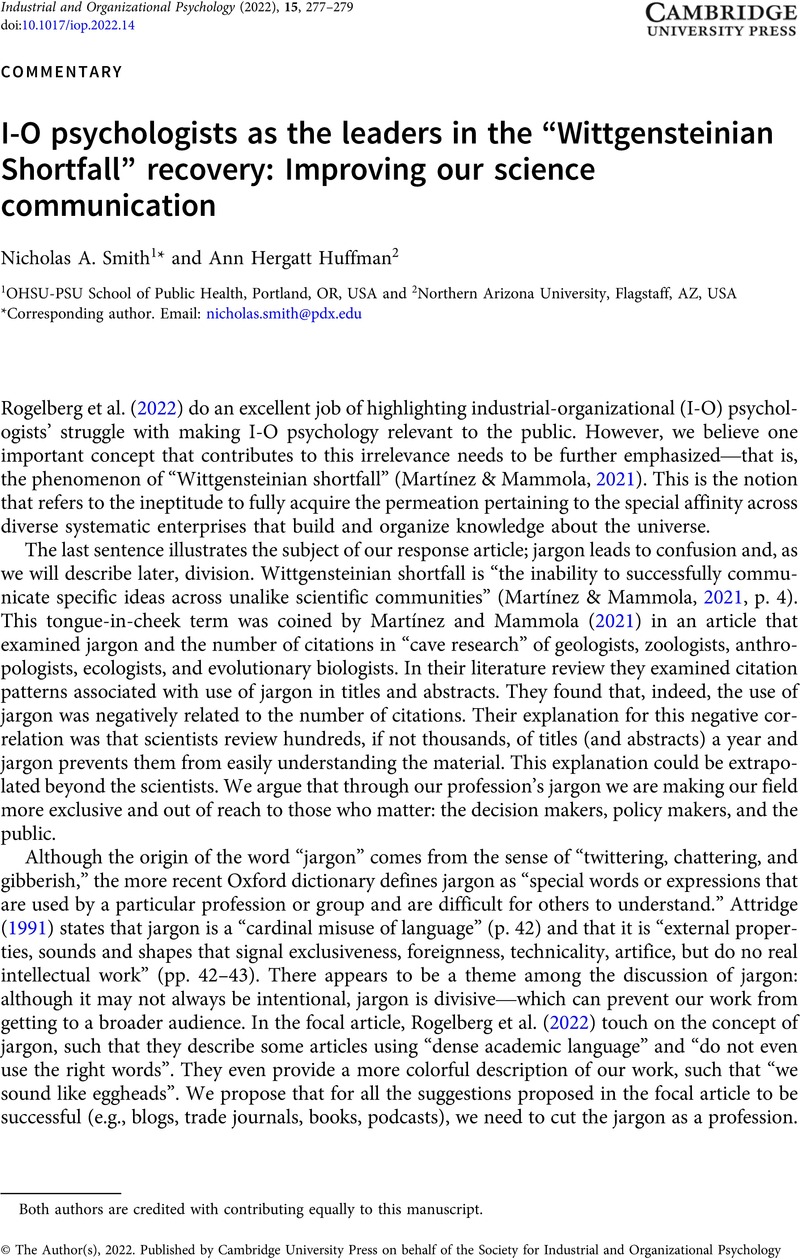No CrossRef data available.
Article contents
I-O psychologists as the leaders in the “Wittgensteinian Shortfall” recovery: Improving our science communication
Published online by Cambridge University Press: 26 May 2022
Abstract
An abstract is not available for this content so a preview has been provided. Please use the Get access link above for information on how to access this content.

- Type
- Commentaries
- Information
- Copyright
- © The Author(s), 2022. Published by Cambridge University Press on behalf of the Society for Industrial and Organizational Psychology
Footnotes
Both authors are credited with contributing equally to this manuscript.
References
Attridge, D. (1991). Arche-Jargon. Qui Parle, 5(1), 41–52. http://www.jstor.org/stable/20685934
Google Scholar
Brownell, S. E., Price, J. V., & Steinman, L. (2013). Science communication to the general public: Why we need to teach undergraduate and graduate students this skill as part of their formal scientific training. Journal of Undergraduate Neuroscience Education, 12(1), E6–E10.Google Scholar
Bullock, O. M., Colón Amill, D., Shulman, H. C., & Dixon, G. N. (2019). Jargon as a barrier to effective science communication: Evidence from metacognition. Public Understanding of Science, 28(7), 845–853. https://doi.org/10.1177/0963662519865687
CrossRefGoogle ScholarPubMed
Hales, H. H., Williams, K. D., & Rector, J. (2017, January 31). Alienating the audience: How abbreviations hamper scientific communication. Association for Psychological Science Observer. https://www.psychologicalscience.org/observer/alienating-the-audience-how-abbreviations-hamper-scientific-communication
Google Scholar
Koopman, J., Conway, J. M., Dimotakis, N., Tepper, B. J., Lee, Y. E., Rogelberg, S. G., & Lount, R. B., Jr. (2021). Does CWB repair negative affective states, or generate them? Examining the moderating role of trait empathy. Journal of Applied Psychology, 106(10), 1493–1516. https://doi.org/10.1037/apl0000837
CrossRefGoogle ScholarPubMed
Kuehne, L. M., & Olden, J. D. (2015). Opinion: Lay summaries needed to enhance science communication. Proceedings of the National Academy of Sciences of the United States of America, 112(12), 3585–3586. https://doi.org/10.1073/pnas.1500882112
CrossRefGoogle ScholarPubMed
Martínez, A., & Mammola, S. (2021). Specialized terminology reduces the number of citations of scientific papers. Proceedings of the Royal Society B: Biological Sciences, 288(1948), Article 20202581. https://doi.org/10.1098/rspb.2020.2581
Google ScholarPubMed
Maurer, T. J., & Lippstreu, M. (2008). Expert vs. general working sample differences in KSAO “improvability” ratings and relationships with measures relevant to occupational and organizational psychology. Journal of Occupational and Organizational Psychology, 81(4), 813–829. https://doi.org/10.1348/096317907X266356
CrossRefGoogle Scholar
Nation, ISP. (2006). How large a vocabulary is needed for reading and listening? Canadian Modern Language Review/La Revue Canadienne des Langues Vivantes, 63(1), 59–82. https://doi.org/10.3138/cmlr.63.1.59
CrossRefGoogle Scholar
Patoko, N., & Yazdanifard, R. (2014). The impact of using many jargon words, while communicating with the organization employees. American Journal of Industrial and Business Management, 4(10), 567–572. https://doi.org/10.4236/ajibm.2014.410061
CrossRefGoogle Scholar
Plavén-Sigray, P., Matheson, G. J., Schiffler, B. C., & Thompson, W. H. (2017). The readability of scientific texts is decreasing over time. eLife, 6, Article e27725. https://doi.org/10.7554/eLife.27725
CrossRefGoogle ScholarPubMed
Rogelberg, S. G., King, E. B., & Alonso, A. (2022). How we can bring I-O psychology science and evidence-based practices to the public. Industrial and Organizational Psychology: Perspectives in Science & Practice, 15(2), 259–272.Google Scholar
Sharon, A. J., & Baram-Tsabari, A. (2014). Measuring mumbo jumbo: A preliminary quantification of the use of jargon in science communication. Public Understanding of Science, 23(5), 528–546. https://doi.org/10.1177/0963662512469916
CrossRefGoogle ScholarPubMed
Stableford, S., & Mettger, W. (2007). Plain language: A strategic response to the health literacy challenge. Journal of Public Health Policy, 28(1), 71–93. https://doi.org/10.1057/palgrave.jphp.3200102
CrossRefGoogle Scholar
Tumpey, A. J., Daigle, D., & Nowak, G. (2018). Communicating during an outbreak or public health investigation. In Rasmussen, S. A. & Goodman, R. A. (Eds.), The CDC field epidemiology manual. Centers for Disease Control. https://www.cdc.gov/eis/field-epi-manual/chapters/Communicating-Investigation.html
Google Scholar




